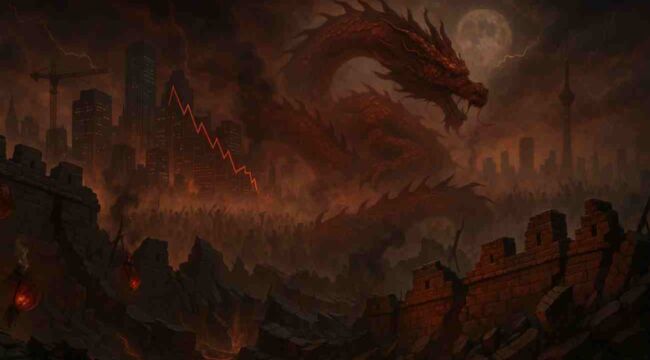China’s Economic and Political Nightmare
When we use the phrase cracking up, we don’t mean an immediate and catastrophic collapse. Instead, we refer to a breakdown in the political, economic and geopolitical spheres that imply a severe weakening in the power of the Chinese Communist Party (CCP) and perhaps even the fall of the CCP over the course of the next few years. That would be a momentous development by any measure.
Of course, such turmoil would not be confined to China and would impact the other global powers including the U.S., Russia and the EU. Even the early stages of such a collapse – happening now – are of enormous consequence for investors. Let’s break this down into politics, economics and geopolitics for an overview of the crisis in China.
The Fall of Xi Jinping
President Xi Jinping of China has lost much, if not all, of his political power. The People’s Liberation Army (PLA), which includes the air force, navy and rocket force is now under the firm control of General Zhang Youxia. Formerly, Zhang was part of a Central Military Commission of which Xi was Chair. Today, Zhang is head of a Central Party Decision-Making and Coordination Body (CP/DMCB), a newly formed entity. Xi is now subordinate to the CP/DMCB, which leaves him no longer in control of the military. This de facto coup was over a year in the making.
Xi Jinping was missing from public view for about six weeks in June and July 2024. When he reappeared in August 2024, he was photographed with a patch of his hair shaved, which could indicate the aftermath of serious neurosurgery. This could have been in response to a transient stroke or other disturbance in the brain.

Power Struggle. China’s economy is far weaker than official reports and Wall Street analysts suggest. That is not the most important news emerging from China. Credible reports suggest that President Xi Jinping’s power has been reduced considerably, and he is now subordinate to an oversight committee led by the head of the People’s Liberation Army. This could presage political chaos as factions struggle for power
It was at this point that the decision was taken to create the CP/DMCB. The announcement was delayed for a year in order give the Politburo time to consider successors and not to disturb U.S.-China relations ahead of the U.S. presidential election.
Other signs of Xi Jinping’s fall from power include the disappearance of General Miao Hua, who was Xi’s top ally in the uniformed military. Xi Jinping’s failure to attend the BRICS Leaders’ Summit in Rio de Janeiro in early July is consistent with this apparent loss of power. Xi does have some remaining power on the civilian side of the CCP, but even that is weakening.
It’s unclear what happens next. The military is turning to factions loyal to Hu Jintao (a former president of China) and Jiang Ximin (another former president who died in 2022) for guidance. Xi has lost what the Chinese call The Mandate of Heaven, the source of political legitimacy. We may see a scramble for power among competing factions or see the CCP turn into a military dictatorship. In all events, political chaos is emerging quickly.
All of this is consistent with 5,000 years of Chinese history. China goes through centuries of centralization including under the emperors of the Shang Dynasty (1600-1046 BC), the Tang Dynasty (618-907 AD) and the Ming Dynasty (1368-1644 AD).
These periods of centralization are followed by periods of decentralization and chaos such as the Three Kingdoms period (220-280 AD), the Sixteen Kingdoms period (304-439 AD) and the period from 1840-1949 AD that included the Opium Wars, the Taiping Rebellion, the Boxer Rebellion, the Warlord period and the Japanese invasion before and during World War II. If the CCP is regarded as a kind of Peasant Dynasty (1949-2025) reaching a peak of centralization at the 20th Party Congress that gave Xi an unprecedented third term in 2022, then decentralization (even disintegration) should not be unexpected.
An Economic Nightmare
The Chinese political stress comes on top of growing economic distress in China. On July 15, 2025, China reported that its economic growth in the second quarter of 2025 was 5.2% (annualized) compared with 5.4% in the first quarter. It’s important to understand that those growth figures are overstated at best and more likely complete fabrications.
Chinese GDP consists of about 45% investment. That investment level is high compared to a mature industrial economy. Investment can be a good path to growth if the investment is prudently allocated in ways that promote growth and cover the cost of capital. Neither condition is true in China. About half of Chinese investment is wasted on ghost cities (large scale urban construction that is completely empty and gradually deteriorating) or white elephant projects such as the Nanjing South train station, which has 128 escalators and relatively little passenger traffic.
If China’s wasted investment were written off (as required under International Accounting Standards), its GDP growth would fall from 5.2% to 4.0%. Even that is an overstatement because China ignores non-performing loans and props up its banks and currency with non-economic bailouts. In fact, China may be in technical recession today.
Other Chinese economic data is equally dismal. Chinese producer prices have fallen for over 30 consecutive months. This is not disinflation; it’s outright deflation that has profound consequences when considered in the context of nominal debt. The math is simple, but the concept is counterintuitive. To understand why, we have to go through the looking glass.
Normally, growth in an economy is reported as a real number. This means inflation has been stripped out. If an economy has 4% nominal growth and 2% inflation, then it has 2% real growth. This is simply a matter of: (4% – 2% = 2%).
But what happens when the price index shows deflation? Deflation is mathematically negative inflation. This means when you adjust nominal growth to real growth, you are subtracting a negative number, which means the deflation adds to real growth. If you have nominal growth of minus 2% and deflation of 4%, then you have real growth of 2%. The math is: [-2% – (-4%) = 2%]. A nominal loss turns into a positive real number when you subtract a negative inflation number.
Here’s the problem. Debt is nominal. You owe what you owe. You cannot pay nominal debt with real growth if the real growth is coming from deflation. You pay nominal debt with nominal growth, and in the case described above, nominal growth is negative. This is the condition China is fast approaching, and it means they’re headed to a debt crisis and default.
The Story Gets Worse
The People’s Bank of China has been working to stimulate the Chinese economy by making liquidity available to the major Chinese commercial banks. The difficulty is that those banks don’t want to lend because of credit risk and economic uncertainty. At the same time, major Chinese corporations don’t want to borrow because they see few attractive investment opportunities.
That condition – banks won’t lend and companies won’t borrow – is characteristic of recessions and depressions. It was exactly what prolonged the U.S. Great Depression in the period 1929-1933 (which had nothing to do with gold by the way). Central bank money has no stimulative impact. It’s up to commercial banks to create money that actually stimulates growth, and they’re not doing that. In the most recent bank credit report, yuan loans contracted sharply for the first time in over twenty years.
This domestic credit contraction is matched by a growing dollar shortage in China. The PBOC has been selling U.S. Treasury securities, not to dump the dollar (it wishes it had more), but to obtain what dollars it can to support its currency and its banks that cannot rollover their dollar liabilities (mostly with Japanese banks in the form of dollar/yen currency swaps).
This will lead to another predictable outcome – a sharp and unexpected devaluation of the yuan similar to the shock devaluation that happened in August 2015. That maxi-devaluation (about 3% in one day) sent U.S. stocks crashing. A similar turn of events is likely on the way.
These specific factors come on top of China’s inability to break out of the middle-income trap. China moved from low income (about $2,000 per capita GDP) to middle-income (about $15,000 per capita GDP) through urbanization, stealing technology and creating assembly-style jobs. To move to high income (about $20,000 per capita GDP or higher) requires original technology and high-value-added manufacturing. China is not capable of this. Even its AI efforts are based on stolen training sets rather than unique algorithms.
Dominating these specific factors is the collapse in the Chinese population. The best estimates are that China’s population will crash from 1.4 billion people to 800 million by 2070. If GDP can be simplified as working age population times productivity, then Chinese GDP must collapse alongside the collapse of its working age population. Productivity gains (if they even exist) cannot make up the difference.
Military Aggression – Strength or Weakness?
This political and economic turmoil is matched by the geopolitical challenges China is facing. With regard to China’s recent military escalation, one must ask whether it’s actually a sign of weakness.
A glance at a map reveals what geopolitical strategists call the first island chain of major islands that surround China in the western Pacific Ocean. These islands begin with the main islands of Japan (Honshu, Hokkaido, Kyushu), a chain of smaller Japanese islands from Amani to Ishigaki, and include Taiwan, the Philippines, the Indonesian archipelago, and Borneo.
South Korea and Malaysia are not technically islands, but they form important chokepoints with the first island chain. Waters between the first island chain and the Chinese mainland have routinely been patrolled by the Chinese Navy albeit with disputes over fishing rights and confrontations with the Philippines’ Coast Guard. Still, China has been considered bottled-up inside this chain. The importance of the first island chain is that it provides a series of chokepoints where oil shipments to China could easily be interdicted.
Now, U.S. complacency about keeping China bottled up has been shattered. China currently has two aircraft carrier groups (including destroyers, cruisers and submarines) operating outside the first island chain and even patrolling in the vicinity of the U.S. Island of Guam, which is almost 3,000 miles from the Chinese coast.
The Chinese Navy looks impressive at sea, but it is not battle tested. Its systems have never operated under actual combat conditions. And it could be a mere distraction from the fact that China’s economy is in distress and President Xi Jinping himself is losing his legitimacy.
Tariffs – The Knockout Punch
If a kinetic war is not imminent (but possible), a trade war is already here. If one considers the three pillars of the Chinese economy to be domestic consumption, investment and trade, then two of those pillars (consumption and investment) are already failing. Chinese retail sales contracted in June and July.Growth in Chinese industrial output has slowed from 7.7% year-over-year in March to 6.8% in June and 5.7% in July. Thanks to Trump’s tariffs, the third pillar (trade) may be about to collapse also.
The exact composition of Trump’s tariffs on China is still under negotiation. The current rate is 30% (a base rate of 10% plus a 20% “fentanyl tariff”) but rates could easily go to 50% or higher if Trump decides to punish China with secondary tariffs for buying Russian oil.
Regardless of the final rate, the impact of tariffs on China, including an industrial slowdown and soaring youth unemployment, are already apparent. Youth unemployment was last reported several months ago at about 27%. We don’t know what it is today because the Chinese simply stopped reporting the data, but it is almost certainly worse. High youth unemployment is the dry tinder for demonstrations and social unrest.
Chinese exports benefitted from some efforts to bring forward demand to beat the tariffs in February and March. It will benefit further because Trump’s recent 90-day extension on tariff negotiations runs past October, which allows most of the Christmas goods deliveries to take place before tariffs are raised. Still, this relief is all temporary. The full impact of U.S. tariff increases will hit China dramatically from November forward.
China expert Gordon Chang points out that the U.S. has bailed out China three times in the past. The first was Nixon’s visit to China in 1972, which propped up Mao Zedong even as his Cultural Revolution was failing badly. The second was George H. W. Bush’s decision not to punish China severely after the Tiananmen massacre in 1989. (Relations did cool but were back on track by 1994). The third was Bill Clinton’s effort to allow China to join the World Trade Organization (WTO) beginning in 1999 that ended with China’s admission to WTO in 2001. Chang’s advice after these three bailouts is “Let’s not do this again.”
He’s right. China is weakening with or without U.S. pressure. Trump may apply the final push in the form of steep tariffs later this year. Still, China’s path is clear including loan defaults, corporate bankruptcies and a maxi-devaluation of the yuan. This is all happening in real time. Investors beware.



Comments: